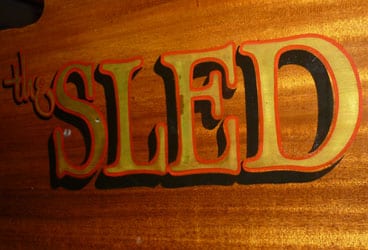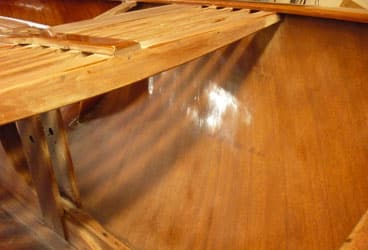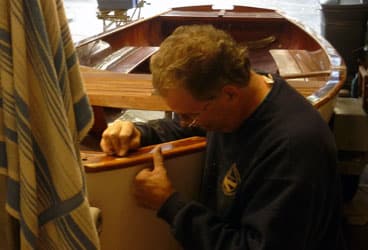
Sled368
It was “double-shot weekend” on 98.5 WNCX, Cleveland’s Classic Rock—perfect music for sanding. I turned the Panasonic to loud, grabbed a few sheets of 240 grit and a foam sanding block, slipped on my Musto kneepads, and crawled into the bow of the Sled, my dad’s Thistle, which I’m in the process of rehabbing in his garage.
Rubbing with the grain of the mahogany plies, I worked my way from the stem on back. David Bowie makes for good sanding. So do Queen, Lynyrd Skynyrd, and the Rolling Stones. I even tolerated the sets by Kansas and Boston. But when Van Halen came on, I stopped for lunch. Because, in my opinion, the only thing worse than one Van Halen song is two Van Halen songs.
The monotony of sanding lulled me into a trance, and I methodically removed the top coat of varnish from every nook and cranny in the bow, folding the paper into origami shapes to reach the slots under the grating and the crevice beneath the mast step. Before I knew it the sun was setting, and I had only reached as far back as the bench seats. By now, my dad had come home, and I lured him into helping me take the shine off the grating. The foredeck grating is one of the focal points of the boat, and I get the feeling Dad didn’t want me to screw it up. He stressed the importance of not sanding too much off the corners, where the varnish tends to run thin, and said to think of the sandpaper as a plane cutting off the top layer of the varnish. On flat surfaces, it’s better to use long, even strokes rather than short, quick ones. I listened long enough for him to finish sanding the grating for me, then called it a day.

_See how the finish is milky from the bow up to the seats? That’s a day’s worth of sanding at Mike-speed.
_

_
_
_I pulled a Tom Sawyer on Dad. _
After I wrote “Taking Baby Steps,” the first entry to my “Tough Sledding” series, I was surprised by the enthusiastic email response. John “Snake” Plominski wrote to tell me how he’s in the process of rebuilding Thistle No. 1109, and how the class’s Facebook page is an excellent source of advice.
Euan Ross wanted to make sure I didn’t ruin what appeared to be a boat in “near perfect” shape. “Don’t strip anything down to the bare wood or attempt skilled jobs in general,” he says. “Just gently and carefully sand and spot treat the bare wood patches…I can recall many occasions in the days when all boats were wood when kack-handed friends’ rehab efforts resulted in a situation where the boat was just so much worse than when they started. Yet somehow they were always proud of it, so maybe that’s okay.”
Joe Norton, who runs Norton Boatworks in Green Lake, Wisc., offered to help answer “any questions that nobody else can answer.” Looking at the before and after photos (below) of a fire-damaged Snipe that the avid one-design racer recently restored, I know Norton will be an excellent resource.

Snipe, before and after. I wonder if Norton restored the cat, too.
_
Two things I neglected to mention in my previous story. Firstly, although I may be a hack, I’m lucky to have the guidance and assistance of my dad, who is not a hack. He’s a former boatbuilder, and he has restored a small fleet of wooden boats. Secondly, I forgot to mention John Riddle’s role in the restoration and upkeep of _the Sled over the years. Racers throughout the Great Lakes know that Riddle is an expert sailor and a woodworking genius, and his Riddle Boatworks has turned out some of the most elegant crafts to grace any body of water. Years ago, Riddle performed an extensive refit on the Sled, installing new rails, rebuilding the centerboard trunk, and fairing the hull. He also crewed on the boat for most of its best regattas.
My dad filled me in on the Sled’s history. “My father bought the boat [No. 1055] from Webb Collart in the mid-’60s,” he said. “Ironically, Webb Collart Jr. ended up with my father’s first Thistle, No. 3, arguably the first one built. Anyway, Webb Sr. thought [1055] was really slow, so when my father bought it from him (cheap), he made him a bet, something like a buck for whoever won the first race they sailed against each other. Webb lost and then double-or-nothing’ed the bet. It went on for a number of years. Webb never beat him. He probably never paid up, either.
“I ‘inherited’ the boat from my father in the late-’70s,” Dad continues. “I rescued it from upside-down storage on the back patio and restored it in his basement. Like wow, man!”
My grandfather won the Thistle class’s second national championship, in 1947, and my father came as close as second place, in 1988. I doubt I’ll ever get that close. Heck, I’ll be lucky to finish this project and step the mast for a Fall Series regatta. But it’s fun to be writing the next chapter in the Sled‘s proud history, and I’m already looking forward to Saturday—as long as it’s not a Van Halen weekend on 98.5.
Have some restoration advice to share? Want to tell your rehab story (boat-related or otherwise)? Email me!









